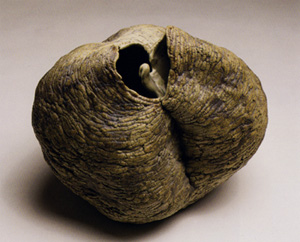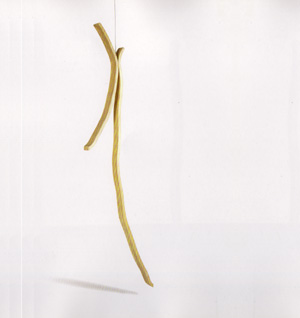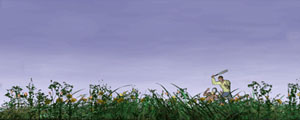Recently I had the opportunity to visit three artists’ studios in Monterrey, Mexico.

Gerardo Azcúnaga... Candado con lengua... 1995... clay, 21.5 x 25.5 x 23.5 cm... Collection Mauricio Fernandez
Situated in Mexico’s northern deserts, Monterrey is a wealthy, industrial city, and the jewel in the country’s economic crown. Between Monterrey and the gigantic Mexico City there exists a quasi-friendly rivalry — the latter viewed as the dissolute, corrupt cause of all Mexico's political and economic troubles; the former seen as an Americanized visual wasteland with little beauty and no taste. Needless to say, the cultural elite of Mexico are centralized in the ancient capital's universities and museums, with Monterrey having long been regarded as a cultural backwater.
So for a Mexican artist to make the conscious decision to live and work in Monterrey is something akin to an American artist choosing to live and work in Texas — with relative freedom, you get relative obscurity. And good Monterrey-based artists are somewhat scarce. That said, with the construction of the MARCO museum in 1990 and the increasing visibility of Monterrey galleries such as Galeria Emma Molina, there is a small, but growing, contemporary visual art community in the Mexican north. Visiting these three artists’ studios offered a glimpse into that world.
Standing on the working-class street in central Monterrey where Gerardo Azcúnaga's studio is located, one would hardly imagine that the grubby little building is where Azcúnaga produces his extraordinarily fecund, somewhat disturbing body of work. Azcúnaga himself is another surprise: an extremely shy person, he stands diffidently in a small wunderkammer of a room that’s chockablock with inspirational objects and books, all lit by a bare bulb.
Azcúnaga is a native Monterreyan, a Regio Montano. He chooses to work not only outside of Mexico’s visual art center; but as a ceramist, he also works in an unloved medium, and makes intentionally unlovable work. His sculpture has a bestial, suggestive quality that is achieved with the skill of an expert ceramist, with surface textures and glazes (or lack thereof) that defy traditional notions of pretty clay pots. Azcúnaga is known for his large, anthropomorphic creatures, which he more recently has whittled down to orifice-like pods that suggest classroom biological models. But unlike the plastic replicas of spleens and livers from high school, Azcúnaga’s creations seem to hum with an inert lifeforce.
His early 1990s work was more explicitly animalistic: large insect-like creatures with gaping, horrific mouths lurched menacingly on spindly wooden legs. The new works are more spare, more subtle and more suggestive. Dreadful creatures have given way to little orbs with slits lined inside with human hair. These works have something both comic and pitiable about them, like disturbing creatures in a pet store window asking us to love them despite the fact of their unsparing biology, unmitigated as it is by sweet puppy eyes or cute kitten whiskers.
Azcúnaga is ultimately interested in the fall from a state of grace. He investigates the debasement and the horror of that which has been cast out from traditional ideas of beauty or acceptable behavior. Azcúnaga's creatures and humorous little orifices have a pathos that appeals from the dark and underappreciated side of things, and his tireless, impeccable production of these works strives for a reevaluation of that which is lovely and lovable.
Cristina Garza is as interested in notions of the ethereal and beautiful as Azcunaga is in the dark and bestial. Garza’s studio is far removed from the gritty neighborhoods of central Monterrey. On the roof garden of her home in the hills above the city, she explores notions of harmony, balance, and gentle interaction in her refined wood sculptures.
Garza's work is about grace: grace of balance, grace of symmetry, grace of a landscape intervention so austere as to become a part of the landscape itself. In this way her work departs from that of Donald Judd (for example), whose own landscape interventions, notably his 15 untitled works in concrete (1980-1984), resist becoming a part of nature not only in their material, but also in the mechanical perfection of their shapes. A visitor to Judd's outdoor installation in Marfa interacts with the landscape via the intermediary presence of the giant concrete boxes, which frame the view and direct movement. In contrast, Garza's spindly wooden sculptures in the desert seem almost indigenous, like giant cactus needles scattered on the ground — natural materials smoothed, it would seem, by the elements and as determined in their gentle curves as sun-bleached bone.
Often in Garza's pieces, two curved pieces of wood gently overlap, or brush up against one another, or are more directly intertwined (as in her hanging Trance pieces, in which wooden noodles loop over each other). Always, the wood is presented as a gently malleable, undulating material frozen in motion. Her hanging sculpture Ecstasy presents two long, supple pieces of wood seemingly frozen at the moment of an ecstatic brushing together. These sculptures occupy sometimes monumental spaces in modest, even demure, ways. They are unconfrontational, graceful, and as gently unassuming yet striking in their form as plants in a Japanese garden.
The studio home of Francisco Larios is one of those highly sophisticated architectural gems that you find in otherwise unexceptional neighborhoods. The house Larios designed, and which he shares with his family, is a contemporary marriage of concrete, wood and glass, with spectacular views of the city.
Of these three artists, Larios has perhaps made the biggest name for himself outside his country, with the Mexico City-based Nina Menocal Gallery featuring his work prominently in this spring’s Armory Show in New York. Larios is known for his series of digital ex votos, and more recently, for his artificial pictures of seemingly pastoral landscapes.
Ex votos are a highly traditional folk art form that is ubiquitous throughout Latin America. These written prayers and supplications, always accompanying a painted image, are generally posted at churches to give thanks or ask for help from a particular saint or martyr. Larios’s own riff on the medium involves highly stylized computer-generated images, which include text that (in one case) thanks the Virgin of Guadalupe for giving the fictional authors’s uncle a job at a pharmaceutical plant “so that he can get drugs and not beat us up anymore.” These are works of satire which retain a sincerity of form, and which play directly on the contradictions between religion and technology that are inherent in modern-day Latin American society. The content of Larios’s made-up prayers may seem farfetched to an American eye, but actual ex votos from countries immersed, still, in the ancient pagan religions as interpreted through the Roman Catholic church are often thus. This series surely packs more of a visceral punch for a Latin American audience — for most Americans, they are a curiosity enlivened by the sometimes bizarre, sometimes tragic, sometimes hilarious stories contained within.
Larios won the first prize at 2001 Cuenca Biennale in Ecuador with his ex votos series. His latest work involves bug-eyed views of lush, computer-generated landscapes, always with a barely-discernible violent or disturbing action taking place in the distant background. Like the veneer of progress in Monterrey that fails to hide the cardboard squatters’ slums creeping up the mountainsides, Larios’s gleamingly artificial landscapes belie a troubled world behind the façade.





